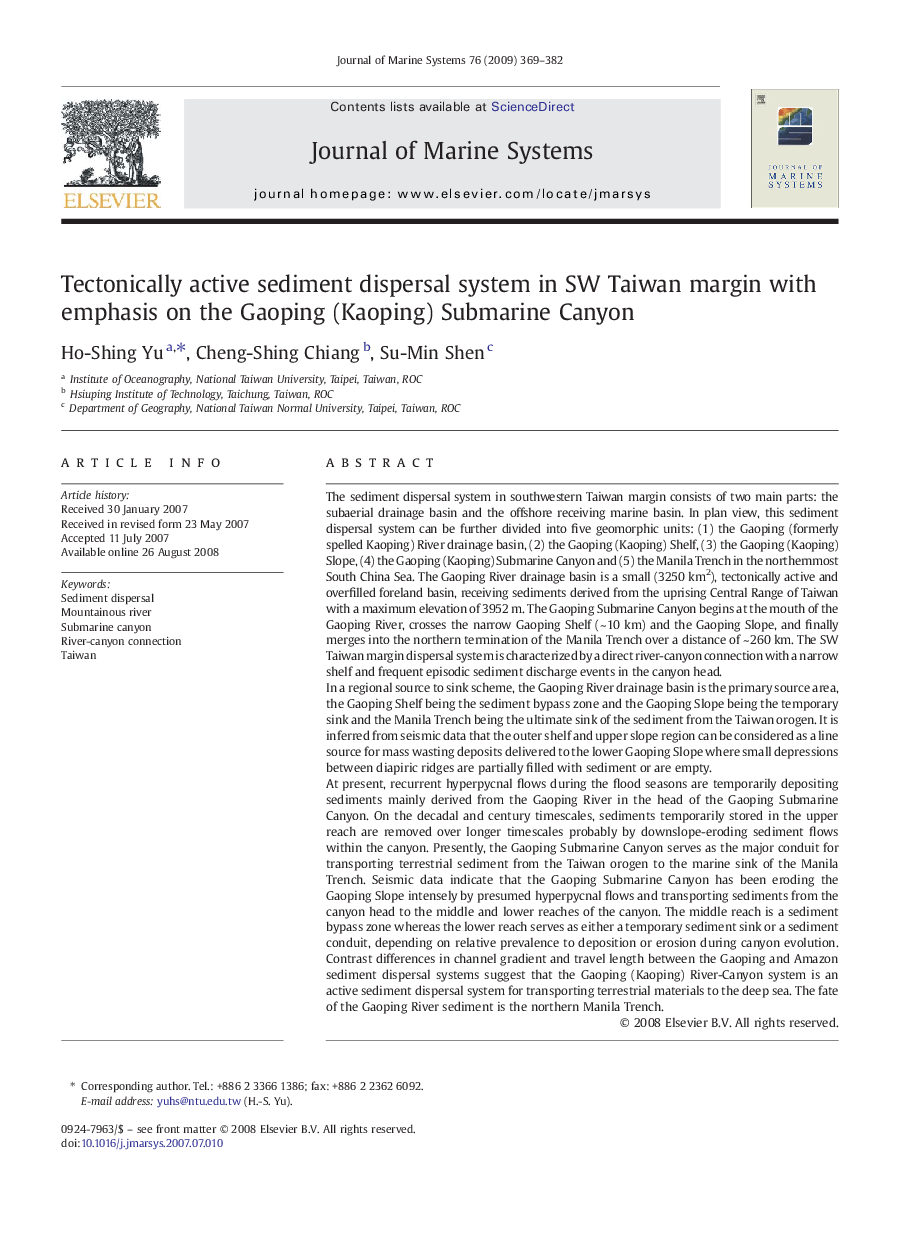| کد مقاله | کد نشریه | سال انتشار | مقاله انگلیسی | نسخه تمام متن |
|---|---|---|---|---|
| 4548782 | 1327929 | 2009 | 14 صفحه PDF | دانلود رایگان |

The sediment dispersal system in southwestern Taiwan margin consists of two main parts: the subaerial drainage basin and the offshore receiving marine basin. In plan view, this sediment dispersal system can be further divided into five geomorphic units: (1) the Gaoping (formerly spelled Kaoping) River drainage basin, (2) the Gaoping (Kaoping) Shelf, (3) the Gaoping (Kaoping) Slope, (4) the Gaoping (Kaoping) Submarine Canyon and (5) the Manila Trench in the northernmost South China Sea. The Gaoping River drainage basin is a small (3250 km2), tectonically active and overfilled foreland basin, receiving sediments derived from the uprising Central Range of Taiwan with a maximum elevation of 3952 m. The Gaoping Submarine Canyon begins at the mouth of the Gaoping River, crosses the narrow Gaoping Shelf (~ 10 km) and the Gaoping Slope, and finally merges into the northern termination of the Manila Trench over a distance of ~ 260 km. The SW Taiwan margin dispersal system is characterized by a direct river-canyon connection with a narrow shelf and frequent episodic sediment discharge events in the canyon head.In a regional source to sink scheme, the Gaoping River drainage basin is the primary source area, the Gaoping Shelf being the sediment bypass zone and the Gaoping Slope being the temporary sink and the Manila Trench being the ultimate sink of the sediment from the Taiwan orogen. It is inferred from seismic data that the outer shelf and upper slope region can be considered as a line source for mass wasting deposits delivered to the lower Gaoping Slope where small depressions between diapiric ridges are partially filled with sediment or are empty.At present, recurrent hyperpycnal flows during the flood seasons are temporarily depositing sediments mainly derived from the Gaoping River in the head of the Gaoping Submarine Canyon. On the decadal and century timescales, sediments temporarily stored in the upper reach are removed over longer timescales probably by downslope-eroding sediment flows within the canyon. Presently, the Gaoping Submarine Canyon serves as the major conduit for transporting terrestrial sediment from the Taiwan orogen to the marine sink of the Manila Trench. Seismic data indicate that the Gaoping Submarine Canyon has been eroding the Gaoping Slope intensely by presumed hyperpycnal flows and transporting sediments from the canyon head to the middle and lower reaches of the canyon. The middle reach is a sediment bypass zone whereas the lower reach serves as either a temporary sediment sink or a sediment conduit, depending on relative prevalence to deposition or erosion during canyon evolution. Contrast differences in channel gradient and travel length between the Gaoping and Amazon sediment dispersal systems suggest that the Gaoping (Kaoping) River-Canyon system is an active sediment dispersal system for transporting terrestrial materials to the deep sea. The fate of the Gaoping River sediment is the northern Manila Trench.
Journal: Journal of Marine Systems - Volume 76, Issue 4, 20 March 2009, Pages 369–382